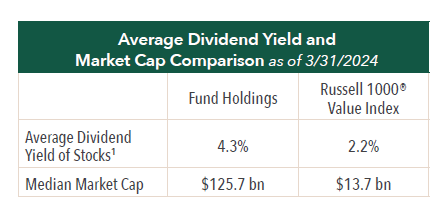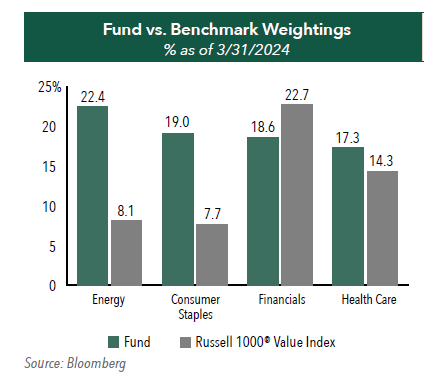High Dividend Yields and Increasing Revenues - An Attractive Combination
In the following commentary, the Portfolio Managers of the Hennessy Cornerstone Value Fund discuss the Fund’s formula-based investment strategy and how it drives the Fund’s sector and industry positioning.
-
 Neil J. HennessyChief Market Strategist and Portfolio Manager
Neil J. HennessyChief Market Strategist and Portfolio Manager -
 Ryan C. Kelley, CFAChief Investment Officer and Portfolio Manager
Ryan C. Kelley, CFAChief Investment Officer and Portfolio Manager -
 L. Joshua Wein, CAIAPortfolio Manager
L. Joshua Wein, CAIAPortfolio Manager
What is the Hennessy Cornerstone Value Fund’s investment strategy?
The Fund utilizes a formula-based approach to build a portfolio of potentially undervalued, profitable, large-cap companies. From the universe of stocks in the S&P Capital IQ Database (excluding utilities), the Fund selects 50 stocks with the highest dividend yield that also meet the following criteria:
» Above-average market capitalization
» Above-average number of shares outstanding
» Trailing 12-month sales 50% greater than average
» Above-average cash flow
Why does the Fund use these screening criteria?
These criteria help the Fund find companies that are large, profitable, and able to pay a healthy dividend. Large market capitalization companies tend to be well-established leaders in their industries with long, successful track records and solid profitability.
A large revenue base is often associated with companies that have a high share of their market or that have diversified successfully.
Above average cash flow identifies companies with strongly profitable business models, possibly generating excess cash flow which may be returned to shareholders in the form of a dividend.
Why does the formula select stocks with the highest dividend yield?
From among the companies that meet the screening criteria, the Fund selects the 50 with the highest dividend yield. As high dividend yield can be a good indicator of a low stock valuation, this ranking criteria helps uncover potentially undervalued companies.

How does the Fund seek to provide a return to investors?
We believe the combination of profitability and value offers investors an opportunity to earn a return in two ways. In our view, the Fund’s investments offer the potential for capital appreciation if and when market sentiment changes and their valuations rise. Investors in the Fund are also “paid to wait,” potentially rewarded with a steady income stream from dividends.
How often does the Fund rebalance its portfolio?
The universe of stocks is re-screened and the portfolio is rebalanced annually, generally in the winter. Holdings are weighted equally by dollar amount with 2% of the Fund’s assets invested in each.
How does the Fund’s portfolio differ from its benchmark?
Compared to its benchmark, the Russell 1000® Value Index, the Fund is most significantly overweight the Energy and Consumer Staples sectors and most significantly underweight Industrials. The Fund’s largest sector weightings include the two overweight sectors mentioned above as well as Financials and Health Care. Of note, the Fund has no exposure to Materials, Real Estate, or Utilities, each of which comprise about 5% of the benchmark.
The Fund’s Energy exposure could continue to benefit from higher commodity prices coupled with any potential improvement in the domestic and global economies. With holdings primarily in large, integrated oil & gas conglomerates, the Fund could benefit from higher cash flows, higher profitability, and benefits to shareholders through dividends, share repurchases, and the reduction of higher costing debt.
In the case of Consumer Staples, the Fund has holdings in soft drinks, packaged foods, tobacco, and other personal and household products. These stocks tend to pay consistent and strong dividends, and we typically see high representation from this sector given our focus on high dividend yielding stocks.
Lastly, the Fund has significant positions in Financials and Health Care, primarily diversified banks and large pharmaceutical companies, which can be less volatile and more defensive in nature, both important attributes for a value focused fund. In the past year, Financials have lagged the overall market yet dividends have held up, thus creating a compelling value proposition to continue investing in the sector. Health Care continues to be a significant portion of the overall fund, which is typical both for this fund as well as many other large cap value funds.

- In this article:
- Domestic Equity
- Cornerstone Value Fund
You might also like
-
 Portfolio Perspective
Portfolio Perspective
Focus FundFrom Rate Cuts to AI: Positioning the Portfolio for Potential Opportunity
 David Rainey, CFACo-Portfolio Manager
David Rainey, CFACo-Portfolio Manager Ira Rothberg, CFACo-Portfolio Manager
Ira Rothberg, CFACo-Portfolio Manager Brian Macauley, CFACo-Portfolio ManagerRead the Commentary
Brian Macauley, CFACo-Portfolio ManagerRead the CommentaryThe Portfolio Managers discuss holdings that could potentially benefit from lower rates, tariffs, and artificial intelligence (AI). The team also provides an update on AST SpaceMobile and discusses potential opportunities in select Technology and Health Care companies.
-
 Company Spotlight
Company Spotlight
Focus FundO’Reilly Automotive—Revved for Growth
 David Rainey, CFACo-Portfolio Manager
David Rainey, CFACo-Portfolio Manager Ira Rothberg, CFACo-Portfolio Manager
Ira Rothberg, CFACo-Portfolio Manager Brian Macauley, CFACo-Portfolio ManagerRead the Spotlight
Brian Macauley, CFACo-Portfolio ManagerRead the SpotlightO’Reilly Automotive is a leader in the automotive aftermarket parts industry in the U.S. The company’s scale, unique distribution infrastructure, and customer service-oriented culture should allow it to take market share in a fragmented U.S. market for years to come.
-
 Portfolio Perspective
Portfolio Perspective
Cornerstone Mid Cap 30 FundPortfolio Drivers: Consumer Discretionary and Industrials
 Neil J. HennessyChief Market Strategist and Portfolio Manager
Neil J. HennessyChief Market Strategist and Portfolio Manager Ryan C. Kelley, CFAChief Investment Officer and Portfolio Manager
Ryan C. Kelley, CFAChief Investment Officer and Portfolio Manager L. Joshua Wein, CAIAPortfolio ManagerRead the Commentary
L. Joshua Wein, CAIAPortfolio ManagerRead the CommentaryCornerstone Mid Cap 30 Fund Portfolio Managers Ryan Kelley and Josh Wein review the Fund’s investment strategy, discuss the most recent rebalance, and highlight the recent change in market cap range of potential investments.
